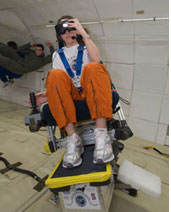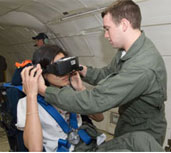HOUSTON — Many people resolved to lose weight this year, but seven university students had a different goal – to be "weightless."
The students served as both investigators and test subjects in an experiment to examine how a person’s sense of direction is impacted by the lack of gravity and whether a simple device can improve the ability to navigate. The student activity, supported by funds from National Space Biomedical Research Institute (NSBRI) and Excalibur Almaz, was conducted through NASA’s Reduced Gravity Student Flight Program.
From different universities, the students volunteered for the project mentored by Dr. Scott Wood of NSBRI’s Sensorimotor Adaptation Team and planned details of the experiment while working as interns last summer at NASA Johnson Space Center.
"We use our sense of gravity as an anchor to orient ourselves, so in a microgravity environment, the sense of down isn’t clear and can cause problems when navigating around a large craft like the space station. The inner ear plays a role in detecting your orientation relative to gravity, so some patients with inner ear disorders have similar navigation problems," said Wood, a scientist at Universities Space Research Association. "The students tested a belt-like device to determine if it improved navigation ability."
Experiments were conducted on an aircraft that simulates the weightlessness, or microgravity, experienced in space by flying a series of steep climbs and descents. As the plane reaches the top of the arc, called a parabola, and heads downward, the participants experience 20-30 seconds of weightlessness. The plane flew 30 parabolas of microgravity, and 6 parabolas of lunar and Martian gravity, which is less than the gravity of Earth.
The students flew two days with three students participating each day. The experiment consisted of a chair fixed in a tilted position that could be rotated and then locked into any one of 360 degrees.
One student served as the subject, seated in the chair wearing sound-cancelling earphones and virtual-reality goggles. The other students ran the experiment. During each microgravity period of the flight, the subject was turned in the chair to a random position and shown an image in their goggles of a location in the plane (cockpit, rear, or left and right side). Then, using a hand-controller, the subject pointed to the direction needed to travel to get to that area of the plane.
"As part of the study, the subject also wore a wide belt containing a series of pager-like vibrators, or tactors, equally spaced. The vibrators in the belt fired to cue the wearer to the direction of the floor," said Justin Barba, the NSBRI student project leader and a biomedical engineering major at Texas A&M University.
During the experiment, the subjects were randomly tested with and without the belt’s "cues." The students will analyze the results of the tests to determine if the belt improved a person’s ability to navigate while in microgravity.
"Navigating in your environment first requires an accurate awareness of your orientation before moving toward a location of interest. On Earth, the ability to sense gravity helps you know which way you are pointing, but in microgravity, one can be easily disoriented especially without appropriate visual information," Wood said. "The students also performed this experiment on the ground using both upright and tilted chair orientations as another way to examine the importance of gravitational cues."
The student flyers hope to publish the results of their study in a scientific journal, but the immediate benefit of the study will be to elementary and middle school classes in the students’ hometowns. "Each of us committed to give presentations to local schools. We hope to teach younger students a little about microgravity and our experiment while showing them that science can definitely be fun," Barba said.
Wood expects the data to show that performance of the task was more difficult in microgravity, but improved when an orientation reference was provided by the belt. On Earth, the upright position will likely be more challenging as the tilted position provides the subject with a better sense of gravity.
The belt could be modified for use in extravehicular activities on the moon. Wood says the tactor vibrators could be programmed to fire in the direction a crew member needs to go.
"Think of it as a non-visual, non-auditory GPS interface. It takes advantage of a sense you aren’t using and helps you navigate, so that vision and hearing can then be focused on other things. It could make astronauts more efficient at lunar survey tasks because they can be guided to locations that don’t have clear terrain markings," Wood said.
The tactor belt could also become a useful aid for patients with neurological disorders experiencing navigation problems.
###
Student investigators/test subjects
Justin Barba, Texas A&M University; Kara Beaton, Johns Hopkins University; Jack Cackler, Stanford University; Stephanie Horsfield, graduate of Ohio University; Kathryn Montgomery, Rice University; Ji Son, University of California, Los Angeles; and Rosario Mercado-Young, University of Texas Medical Branch.
Student participation supported through funding from:
Excalibur Almaz
Excalibur Almaz is a private corporation whose goal is to accelerate the peaceful use of outer space for exploration, research and science. Using proven space technology, the company plans to make spaceflight affordable and accessible for a broad range of customers.
National Space Biomedical Research Institute (NSBRI)
NSBRI, funded by NASA, leads a science and technology program to develop countermeasures, or solutions, to the health-related problems and physical and psychological challenges men and women face on long-duration spaceflights. The Institute’s science, technology and education projects take place at more than 60 institutions across the United States. The research results and medical technologies developed have impact for similar conditions experienced on Earth, such as osteoporosis, muscle wasting, shift-related sleep disturbances, balance disorders, and cardiovascular and immune system problems.







